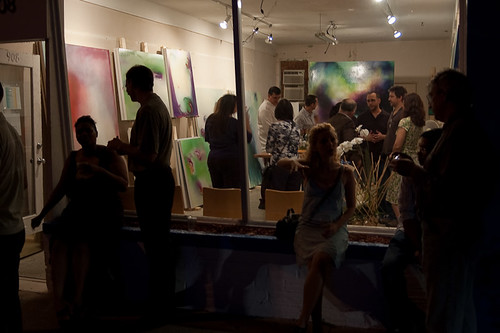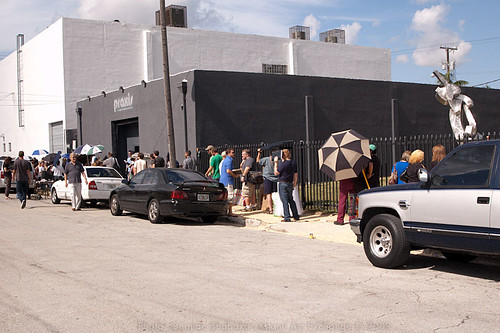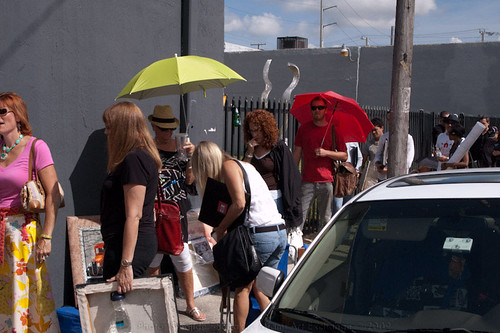Like many artists, Tonietta Walters struggles with her practice. She is challenged by her practice. And, she is enveloped by her practice in ways that many of us can relate to. It grabs her, shakes her around, asks her tough questions that she cannot always answer. This is the place where we find ourselves, about to enter her studio, the threshold of a place that is uncomfortable but, it’s where she creates and brings into being including, all the things we have just tried to explain.
Miamiartexchange.com: We exhibited your work on Miamiartexchange.com Gallery back in January, 2004 and there is still a similarity in the work we see in your studio today. What attracts you to this material and what is it? How do you work with it?
Tonietta Walters: The material is latex but I also use fiberglass resin. I use it because of its texture and its tactile qualities. I started using these as an undergrad because I like the way it takes on the memory of a surface or form. I like the natural color of latex when it dries. I like the way it allows me to work through my art making process. I’m very much a process oriented person and find I work best if I am in a process heavy, creative mode.
A few years ago I painted on latex that was stretched on a frame like a regular painting but, for the most part, I prefer to use it more organically or freely and have used it in sculptural forms. The one thing about latex is that it degrades over time just as memory does. An example of this deterioration can be found in the two flat pieces I have with steel shavings embedded into them.. One of them is deteriorating faster than the other. (image above)
M: Those two types of works, the latex stretched on the frame and the flat pieces with steel shavings, are very different. The ones that are stretched tell the regular viewer this is a finished, completed work. It’s final. Yet it’s not when thinking about how the material is going to change rapidly over time. The flat pieces are much more conceptual and one would have the expectation that there is some fluidity in them, especially when you’re so heavily invested in process. It seems that you have something to work through there however, I know a major part of the concern is the audience, your audience as you’ve found them. You used the word “honesty” in talking about your relationship with your audience and maybe there is a something disingenuous in your approach.
T: There’s also in the work the concept of a “framing” or memory capture of the more visceral aspects of experience: some of the pieces have that and some don’t. If I had my choice, I’d do installations. I did an installation at the Broward Main Library, 6th Floor gallery, that included paintings, sculptures surrounded by sand and the tiles you see here, made from plaster onto which I inscribed the various languages, cuneiform, greek, binary code, etc, I will reuse the tiles in other installation work. I’m currently working on a similar installation with sand (see image above) and although I have some initial ideas about what I want, I work until the piece is finished in my mind. I don’t direct myself in that way, it’s about “flow.”
M: There seems to be a certain expectation, true or not, that the visual art audience from the Caribbean basin have preconceived notions as to what art is or what art should be. The dichotomies in your work express that. If we compare the latex pieces for instance, stretched on a frame and flat without a frame, points to that. What I’m getting at is, how do you break free from somebody else’s expectations? You know, the “average” art audience knows, Picasso, Warhol, Dali, and Pollack for the most part, so how do you do something different than that (thinking about the poured flat latex pieces) and still have this audience here in Lauderhill specifically accept and embrace lots of difference, including conceptual work?
T: Yes, well, that is kind of our mission here at our Center. We want to give our gallery and the resident artists the opportunity to be more freeform and open to different things.
You haven’t said anything about the digital pieces you’re doing, could you tell me about them?
T: Well, they come from Second Life, you do know what that is, right?
M: Not really. I’ve heard of Second Life but I don’t know what it is.
T: Okay, Second Life is a multiple online role-playing game where you can create a character, an avatar, and the environment for that character. So, what I did was set up a studio in Second Life with a gallery and a loft living space. I took it as an opportunity to learn how to build in 3-D. So, I go around and take pictures of myself and other people. I’m like a photographer. It is the same kind of thing as a memory capture of another version of me, but I admit to sometimes using the game as a substitute for working with 3-D sculpture proper. I have, however, created a couple of maquettes in Second Life that I used with a couple of proposals. So, that has been helpful.
So these pieces (see image above) are photos of my avatar that I have photographed in the game and printed out and applied to canvas including some painting. Her name is XhyraGraf. Even though most of my recent work has been in Second Life, my sculptural practice has remained important and that is where I’m currently refocusing my energies.
M: Well, thank you Tonietta for allowing me into your studio for this little visit and interview.
T: You’re most welcome.
[Afterword by Ms. Walters: Actually, the work itself is not at all a place of discomfort or struggle and is also a place for the finding of answers. The discomfort is balancing the time to do the work with obligations and making sure I don’t bring baggage to the process.
But, this is about your (the interviewer, Onajide Shabaka’s) interpretation.
I am probably at a place of discomfort now but it has nothing to do with the artwork — more with reconciling with the fact that I am a bit disconnected from the work and allowing myself to claim my time as my own so I can reconnect with the work.
Sometimes it is challenging, yes [in the way familiar to most artists] but the kind of challenge that my art practice provides is the only place I am comfortable. I use the word ‘practice’ much as a doctor or psychiatrist would open up private practice. It in no way means I am unsure of what my skills are or what I am doing or the kind of results I am hoping to achieve.]













![Reblog this post [with Zemanta]](http://img.zemanta.com/reblog_e.png?x-id=a39ccf99-9fd7-487b-87c1-49aa31ebc05d)








![Reblog this post [with Zemanta]](http://img.zemanta.com/reblog_e.png?x-id=935ae4b6-57cc-41dc-8133-2ce8e149af79)